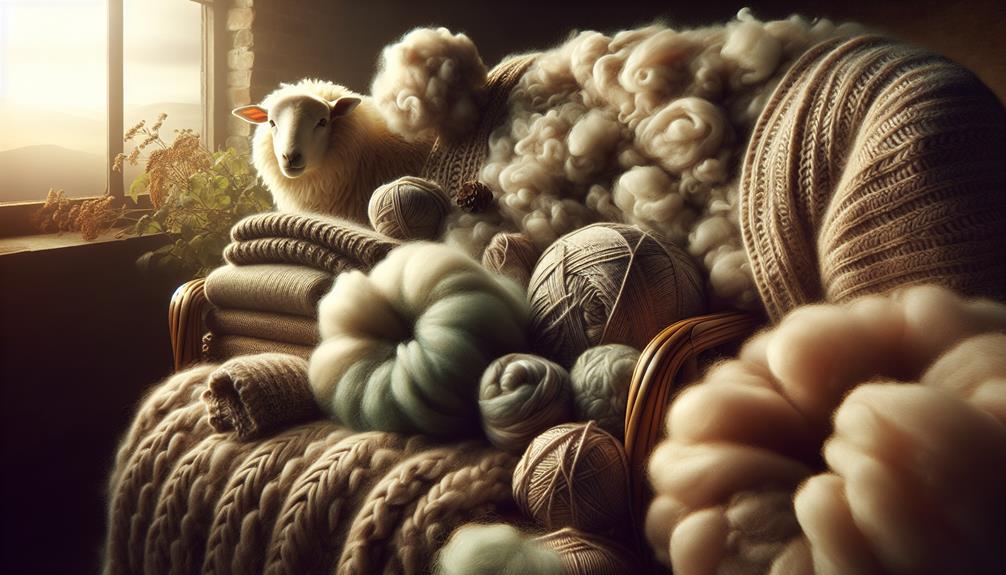I can tell you that wool is incredibly elastic, flame-resistant, great at wicking moisture, a superb insulator, and highly durable. These characteristics make wool a popular choice for many uses.
Table of Contents
Key Takeaways
- Impressive elasticity due to keratin's helical structure
- Exceptional flame resistance from high moisture content
- Efficient moisture-wicking properties with up to 30% absorption
- Excellent insulating ability by trapping air in wavy fibers
- Demonstrates exceptional durability through elasticity and shape retention
Elasticity of Wool
Wool displays impressive elasticity, thanks to its unique keratin polypeptide chains that form a helical structure. This elasticity allows wool fibers to stretch considerably without breaking, up to 30% more when dry and 50% more when wet. The helical structure of keratin contributes to wool's ability to endure bending up to 20,000 times without losing its shape, highlighting its flexibility and resilience.
The tear resistance of wool is closely linked to its elasticity, making it a durable material suitable for various applications where endurance is key. Wool's ability to retain its shape and integrity even after repeated stretching sets it apart from other fibers. This quality also makes wool an ideal choice for garments and textiles that require both flexibility and tear resistance. Essentially, wool's elasticity is a fundamental characteristic that underpins its versatility and durability in a wide range of uses.
Flame Resistance of Wool
The exceptional flame resistance of wool stems from its unique ability to retain moisture within its fibers, making it a naturally safe material for various applications. Wool's high moisture content acts as a barrier against ignition, as it's difficult to ignite and burns slowly. With a high ignition temperature, wool reduces the risk of catching fire easily, providing a safe environment. Even aged wool maintains its fire-resistant properties, offering long-lasting protection against flames.
This flame resistance is an inherent characteristic of wool fibers, setting it apart as a safe material in different settings. Wool's ability to resist fire makes it a valuable choice for products where safety is a top priority. The natural properties of wool contribute to its reputation as a reliable and durable material that provides peace of mind regarding fire safety.
Moisture-Wicking Properties of Wool
With its remarkable ability to absorb up to 30% of its weight in moisture without feeling wet, wool's moisture-wicking properties set it apart as a superior material for various applications.
The crimp design of wool fibers plays a pivotal role in this feature by creating tiny air pockets that assist in moisture absorption and retention. This unique structure enables wool to efficiently wick moisture away from the body, enhancing comfort in diverse conditions.
Moreover, wool's moisture-wicking nature not only keeps the wearer dry but also prevents the growth of mold and mildew, ultimately boosting its durability.
The hygienic and comfortable characteristics of wool, stemming from its moisture-wicking properties, make it an excellent choice for clothing and textiles where staying dry and fresh is essential.
The combination of moisture absorption, air pocket formation, and efficient moisture-wicking abilities make wool a top contender for those seeking reliable, comfortable, and long-lasting materials.
Insulating Ability of Wool
Experiencing the cozy warmth of wool in cold weather is a direct result of its natural crimp that effectively traps air, creating a thermal barrier for insulation. Wool's insulating ability is remarkable due to its unique characteristics:
- Natural Crimp: Wool fibers have a wavy structure that creates tiny pockets of air within the material, enhancing its insulating properties.
- Heat Retention: The crimp in wool fibers helps the fabric retain heat close to the body, making it an excellent insulator in cold weather conditions.
- Regulating Body Temperature: Wool's insulation not only keeps you warm in winter by trapping body heat but also helps regulate body temperature as needed, making it versatile for various climates.
Unlike synthetic fibers, wool can retain a significant portion of its insulating properties even when wet, making it a reliable choice for maintaining warmth and comfort in cold environments.
Embracing wool garments is a smart choice for those seeking effective insulation and temperature regulation in diverse weather conditions.
Durability of Wool
Boasting impressive resilience, wool demonstrates exceptional durability through its ability to withstand repeated bending without breaking. The elasticity of wool fibers plays a vital role in preventing breakage, making woolen items long-lasting.
Unlike other materials, wool garments have the remarkable ability to retain their shape, showcasing their durability over time. Even as wool ages, it maintains its fire-resistant properties, ensuring that it remains a safe and durable choice for various uses. The natural fire resistance of wool not only adds to its longevity but also enhances its safety features.
Its capacity to resist fire makes wool a reliable material for different applications, emphasizing its durability and practicality. Wool's durability, combined with its fire-resistant nature, makes it a sustainable and enduring choice for a wide range of products, from clothing to home furnishings.
Frequently Asked Questions
What Is the Characteristic of Wool?
Wool's unique properties, like elasticity, tear resistance, and insulation due to its keratin composition, make it a highly versatile fiber. Its ability to absorb moisture and adapt to temperatures provides comfort and durability.
What Are 5 Facts About Wool?
Wool is a versatile fiber that boasts natural UV protection, antimicrobial properties, stain resistance, and easy-care features. Its ability to regulate body temperature year-round is a standout characteristic, keeping me comfortable in any season.
What Trait Is Wool Known For?
Wool is renowned for its natural UV protection, shielding with an SPF of 30+. Its antibacterial properties, stain resistance, and insulation even when wet make it a versatile and durable choice for all seasons.
What Are 5 Useful Items Made From Wool?
Wool creates cozy blankets, stylish sweaters, high-quality carpets, luxurious scarves, and traditional felted hats. Each item offers warmth, insulation, softness, elegance, durability, and style. Wool's versatility and natural beauty make it a timeless choice for various products.
- Tetron Fabric for Marine Applications: Durability and Use Cases - June 18, 2025
- Tetron Fabric for Outdoor Furniture: Weather Resistance and Care - June 18, 2025
- Tetron Fabric for Wall Coverings: Style and Application Tips - June 18, 2025






